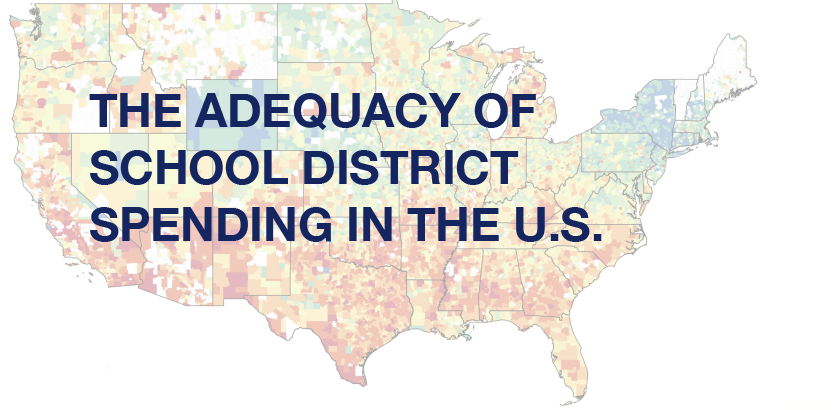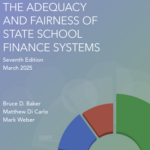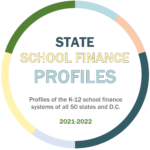Research Brief 02-2021 (March 2021)

Download
Authors
Bruce D. Baker
Matthew Di Carlo
Mark Weber
Summary
It’s fairly common knowledge that U.S. school districts vary widely in terms of funding. But that’s not necessarily a bad thing. In fact, in an ideal school funding system, we would expect to see differences between districts in their spending levels, even big differences, for the simple reason that the cost of educating students varies a great deal across districts.
For instance, some districts serve larger shares of high-need students than others, and the former require more resources to achieve a given level of student performance. Similarly, like any employer, districts have to pay competitive wages, and labor costs also vary substantially by location. Teachers in areas with high costs of living, for example, have to be paid more than their colleagues in small rural towns where living is less expensive.
In short, unequal spending is acceptable and even desirable if it is aligned with unequal costs. The key question is whether districts have the resources to meet their students’ needs. In other words, is school district spending adequate?
This research brief presents key findings from a new public database of funding adequacy for over 12,000 U.S. public school districts. The database (the District Cost Database) allows one to compare each district’s actual per-pupil spending with estimates of adequate per-pupil spending levels—that is, spending levels that would be required to achieve the goal of U.S. average test scores (a common “benchmark” with which the models assess adequacy). The data are for the 2017-18 school year.
The brief reports some good news. Thousands of districts enjoy funding levels above and beyond estimated adequate levels. You can find these districts in every single U.S. state. In some cases, funding is two or three times higher than the targets. Even in states such as Arizona and New Mexico, where large majorities of students attend schools in underfunded districts, there are numerous districts in which spending exceeds estimated requirements.
Yet these districts co-exist with thousands of other school systems, some located within driving distance or even in the next town over, where investment is so poorly aligned with need that funding levels are a fraction of estimated costs. Districts with negative funding gaps are especially prevalent throughout the southeast and southwest, but they are a national problem. They are found in rich and poor states, big and small states, and in red and blue states. This includes, for instance, Massachusetts and Connecticut: in both of these states, most districts spend above—often far above—adequacy targets, but around one in five students still attends school in a district where funding is below estimated required levels.
Nationally, the sum of these negative gaps (not counting districts with adequate funding) comes to $104 billion. The average negative gap is $4,254 per-pupil, or 25.6 percent below the adequate level.
Finally, the brief reports that funding tends to be more inadequate—or less adequate—in districts with higher Census child poverty rates, as well as in districts serving larger shares of students of color, especially Hispanic/Latinx students. These associations are among the only consistent features underlying the heterogeneity of district funding adequacy. For example, 86 percent of the roughly 1,000 districts with majority Hispanic/Latinx student populations spend below estimated adequate levels.
To be clear, these adequate spending estimates are necessarily imperfect. Estimating education costs across over 12,000 districts in 49 states and the District of Columbia is a challenge (Hawaii is not included because the state consists of a single district). No model can control for everything that affects education costs, and what the models do control for is measured imprecisely (for example, the authors have specific concerns about reported funding data in New York and Vermont). In addition, full implementation of adequate funding levels from a perfect model using perfect data would not raise student outcomes immediately and uniformly. Real improvement is gradual and requires sustained investment.
What the District Cost Database does offer is reasonable estimates for assessing funding adequacy across the U.S. and, ultimately, for improving policy. As a whole, the results in this brief suggest that virtually no states are succeeding in their role of providing equal educational opportunity for all their students, and many are seriously failing, with student outcomes to match.
The authors offer recommendations for how these data might help to guide a strategic expansion of the federal role in education finance, as well as a fundamental recalibration of how many states fund their schools. This includes: 1) targeting federal funds at districts with below-adequate funding and poor student achievement outcomes, particularly in states with more limited fiscal capacity to pay these costs themselves; and 2) incentivizing higher-capacity states to boost their own revenue and target resources according to districts’ needs.
Download: research brief | press release | full dataset | online data visualization
Published March 2021
Authors: Bruce D. Baker, Matthew Di Carlo, and Mark Weber
An earlier version of the district database was published in 2020 by the Century Foundation. We are grateful to Century for their support of this project.
Latest News
 UPDATED ANNUAL REPORT, PROFILES, AND DATASETS AVAILABLE
UPDATED ANNUAL REPORT, PROFILES, AND DATASETS AVAILABLE
March 2025: Read the seventh edition of our annual report, view your state’s one-page finance profile, use our data visualizations, or download the full state- and district-level dataset.
Latest Annual Report
 The Adequacy and Fairness of State School Finance Systems (7th edition)
The Adequacy and Fairness of State School Finance Systems (7th edition)
The seventh edition of our annual report presenting findings on effort, statewide adequacy, and equal opportunity in state school finance systems. Published March 2025.
Latest Research Briefs
 State School Finance System Profiles (2021-22 school year)
State School Finance System Profiles (2021-22 school year)
One-page profiles summarizing the key results on effort, statewide adequacy, and equal opportunity for all 50 states and D.C. View your state’s profile. Published March 2025.




